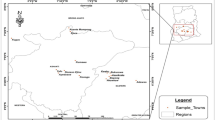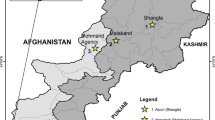Abstract
In recent years, a series of environmental and ecological problems have occurred due to enhanced anthropogenic disturbances for precious mineral mining. Traditional medicines have become an important pillar in national homeopathic treatment system, especially in mountainous environment of developing countries. The current study investigated the level of potentially toxic elements’ (PTEs) contamination in degraded mining soils and medicinal plants along the mafic–ultramafic rocks in Kohistan region. Soil samples and medicinal plant species were collected from the degraded mining areas and screened for PTEs (Pb, Cr, Ni, Mn, Zn and Cd) using atomic absorption spectrometry (AAS-Perkin-Elmer, 2380). Various pollution indices were used for PTEs such as contamination factor (CF), pollution load index (PLI) and translocation factor (TF) in degraded mining soils and medicinal plants. The mean concentrations of selected PTEs in soil were in the order of Mn > Ni > Cr > Pb > Zn > Cd, while in medicinal plants the mean concentrations were in the following order: Pb > Cr > Mn > Ni > Zn > Cd. Highest bioaccumulation was observed in Ajuga bracteosa (Cr = 349 mg kg–1), Phlomis bracteosa (Pb = 335 mg kg–1), Chenopodium ambrosioides (Mn = 304.3 mg kg–1), Isatis costata (Ni = 169 mg kg–1), Ajuga parviflora (Zn = 38.4 mg kg–1) and Salvia moorcoftiana (Cd = 11 mg kg–1). Furthermore, the concentrations of PTEs were significantly higher (p < 0.001) in degraded mining soils and medicinal plants than the reference site, which may be attributed to the mining and open dumping of mining wastes. The present study reveals that chromite mining and open dumping of mining wastes can cause serious environmental problems in the study area. Furthermore, medicinal plants grown in degraded mining soils may pose risk to the local inhabitants as most of the people consume these plants for various health problems.

Similar content being viewed by others
References
Ahmed E, Arshad M, Saboor A, Qurehi R, Mustafa G, Sdiq S, Chaudhari SK (2013) Ethnobotanical appraisal and medicinal use of plants in Patriata, New Murree, evidence from Pakistan. J Ethnobiol Ethnomed 13:1–10
Ali SI, Qaiser M (1986) A phytogeographical analysis of the phanerogams of Pakistan and Kashmir. Proc R Soc Edinburg 89B:89–101
Baker AJM, Brooks RR (1989) Terrestrial higher plants, which hyperaccumulate metallic elements—A review of their distribution, ecology and phytochemistry. Biorecovery 1:81–126
Baye H, Hymete A (2010) Lead and cadmium accumulation in medicinal plants collected from environmentally different sites. Bull Environ Contam Toxicol 84:197–201
Caldasa ED, Machado LL (2004) Cadmium, mercury and lead in medicinal herbs in Brazil. Food Chem Toxicol 42:599–603
Dogheim SM, El Ashraf MM et al (2004) Pesticides and heavy metals levels in Egyptian leafy vegetables and some aromatic medicinal plants. Food Addit Contam 21(4):323–330
Durgnat JM, Heuser J, Andrey D, Perrin C (2005) Quality andsafety assessment of ginseng extracts by determination of the contents of pesticides and metals. Food Addit Contam 22(12):1224–1230
Ebrahim AM, Eltayeb MH, Khalid H, Mohamed H, Abdalla W, Grill P, Michalke B (2012) Study on selected trace elements and heavy metals in some popular medicinal plants from Sudan. J Nat Med 66(4):671–679
Fatima I, Anis I, Ahmad I et al (2007) A new alkaloid from isatis Costata. Turk J Chem 31(4):443–447
Ghiasuddin RTU et al (2011) Antimicrobial, insecticidal and phytotoxic activities of indigofera heterantha roots. J Med Plant Res 5(24):5835–5839
Harris ES, Cao S, Littlefield BA, Craycroft JA, Scholten R, Kaptchuk T, Yanling Fu et al (2011) Heavy metal and pesticide content in commonly prescribed individual raw Chinese herbal medicines. Sci Total Environ 409:4297–4305
Hazrat A, Shah J et al (2010) Medicinal plants of usherai valley, Dir, NWFP Pakistan. Pak J Bot 42(1):31–34
Hina B, Rizwani GH, Naseem S (2011) Determination of toxic metals in some herbal drugs through atomic absorption spectroscopy. Pak J Pharm Sci 24:353–358
Jabeen S, Shah MT, Khan S, Hayat MQ (2010) Determination of major and trace elements in ten important folk therapeutic plants of haripur basin. Pak J Med Plants Res 4(7):559–566
Khan MA, Ahmad I, Rahman I (2007) Effect of environmental pollution on heavy metals content of Withania somnifera. J Chin Chem Soc 54:339–343
Khan SA, Khan L et al (2008) Profile of heavy metals in selected medicinal plants. J Weed Sci Res 14(12):101–110
Khan A, Khan S, Khan MA, Qamar Z, Waqas M (2015) The uptake and bioaccumulation of heavy metals by food plants, their effects on plants nutrients, and associated health risk: a review. Environ Sci Pollut Res 22(18):13772–13799
Kumar M, Paul Y, Anand VK (2009) An Ethnobotanical study of medicinal plants used by the locals in Kishtwar, Jammu and Kashmir. India J Ethnobiol Ethnomed 13(1956):1240–1256
Lajayer A, Behnam GM, Nikabadi S (2017) Heavy metals in contaminated environment: destiny of secondary metabolite biosynthesis, oxidative status and phytoextraction in medicinal plants. Ecotoxicol Environ Saf 145:377–390
Lasisi AA, Yusuff AA, Ejelonu BC, Nwosu EO, Olayiwola MA (2005) Heavy metals and macronutrients content in selected herbal plants of Nigeria. Int J Chern 15:147–154
Muhammad S, Shah MT, Khan S (2011) Heavy metal concentrations in soil and wild plants growing around Pb-Zn Sulfide Terrain in the Kohistan Region. Northern Pak Microchem J 99(1):67–75
Muhammad S, Shah MT, Khan S et al (2013) Wild plant assessment for heavy metal phytoremediation potential along the mafic and ultramafic terrain in Northern Pakistan. BioMed Res Int 2:194765
Muller G (1969) Index of geo-accumulation in sediments of the Rhine 680 River. Geol J 2:108–118
Mutlu SI, Seven I, Arkali G et al (2021) Ellagic acid plays an important role in enhancing productive performance and alleviating oxidative stress, apoptosis in laying quail exposed to lead toxicity. Ecotoxicol Environ Saf 208:111608
Nawab J, Khan S, Shah MT, Qamar Z et al (2015a) Contamination of soil, medicinal, and fodder plants with lead and cadmium present in mine-affected areas, Northern Pakistan. Environ Monit Assess 187:9
Nawab J, Khan S, Shah MT, Khan K et al (2015b) Quantification of heavy metals in mining affected soil and their bioaccumulation in native plant species. Int J Phytorem 17(9):801–813
Nawab J, Khan S, Shah MT, Gul N, Ali A, Khan K, Huang Q (2016a) Heavy metal bioaccumulation in native plants in chromite impacted sites: a search for effective remediating plant species. Clean: Soil, Air, Water 44(1):37–46
Nawab J, Li G, Khan S, Sher H et al (2016b) Health risk assessment from contaminated foodstuffs: a field study in chromite mining-affected areas northern Pakistan. Environ Sci Pollut Res 23(12):12227–12236
Okatch H, Ngwenya B, Raletamo KM, Marobela KA (2012) Determination of potentially toxic heavy metals in traditionally used medicinal plants for HIV/AIDS opportunistic infections in Ngamiland District in Northern Botswana. Anal Chim Acta 730:42–48
Okello J, Paul S (2007) Medicinal plants used by communities of Ngai Subcounty, Apac District. Northern Ugand Afr J Ecol 45(1):76–83
Okem A, Southway C, Stirka WA, Street RA, Finniea JF, Staden JV (2014) Heavy Metal Contamination in South African Medicinal Plants: A Cause for Concern. S Afr J Bot 93:125–130
Quig D (1998) Cysteine metabolism and metal toxicity. Altern Med Rev 3:262–270
Rahimzadeh MR, Kazemi S, Moghadamnia AA (2017) Cadmium toxicity and treatment: an update. Caspian J Intern Med 8(3):135
Rana JC, Pradheep K, Chaurasia OP et al (2012) Genetic resources of wild edible plants and their uses among tribal communities of cold arid region of India. Genet Resour Crop Evol 59(1):135–149
Rehman A, Iqbal H, Rehman HU et al (2013) Study of heavy metals in medicinal plant solanum xanthocarpum. Int J Sci Innov Discov 3(2):254–260
Sadhu A, Upadhyay P, Singh PK et al (2015) Quantitative analysis of heavy metals in medicinal plants collected from environmentally diverse locations in India for use in a novel phytopharmaceutical product. Environ Monit Assess 187:542
Sarac N, Ugur A (2007) Antimicrobial activities and usage in folkloric medicine of some lamiaceae species growing in Mugla, Turkey. EurAsian J BioSci 4:28–37
Sekar CK, Rawat B (2011) Diversity, utilization and conservation of ethnomedicinal plants in Devikund—A high altitude, sacred wetland of Indian Himalaya. Med Plants 3(2):105–112
Shabana MM, Mirhom YW, Genenah AA, Aboutabl EA, Amer HA (1990) Study into wild Egyptian plants of potential medicinal activity. Arch Exp Veterinarmed 44:389–394
Sharma RA, Singh B, Singh D, Chandrawat P (2009) Ethnomedicinal, pharmacological properties and chemistry of some medicinal plants of boraginaceae in India. J Med Plants Res 3(13):1153–1175
Shen ZJ, Xu DC, Chen YS, Zhang Z (2017) Heavy metals translocation and accumulation from the rhizosphere soils to the edible parts of the medicinal plant fengdan (Paeonia Ostii) grown on a metal mining area, China. Ecotoxicol Environ Saf 143:19–27
Shinwari ZK, Gilani SS (2003) Sustainable harvest of medicinal plants at Bulashbar Nullah, Astore (Northern Pakistan). J Ethnopharmacol 84(2–3):289–298
Shinwari ZK, Qaiser M (2011) Efforts on conservation and sustainable use of medicinal plants of Pakistan. Pak J Bot 43:5–10
Street R, Kulkarni MG, Stirk WA, Southway C, Van Staden J (2008) Variation in heavy metals and microelements in South African medicinal plants obtained from street markets. Food Addit Contam Part A 25(8):953–960
Ullah R, Hussain IS, Ahmad S (2013) Phytochemical and biological evaluation of phlomis bracteosa: a review. Life Sci J 10(7):1190–1192
Wang J, Su J, Li Z, Liu B et al (2019) Source apportionment of heavy metal and their health risks in soil-dustfall-plant system nearby a typical non-ferrous metal mining area of tongling, Eastern China. Environ Pollut 254:113089
WHO. WHO: Geneva Switzerland; 1998. Quality control methods for medicinal plant materials. available at http://whqlibdoc.who.int/publications/1998/9241545100.pdf
Wu LY, Gao HZ, Wang XL et al (2010) Analysis of chemical composition of chrysanthemum indicum flowers by GC/MS and HPLC. J Med Plants Res 4(5):421–426
Zeng J, Li X, Wang X et al (2020) Cadmium and lead mixtures are less toxic to the Chinese medicinal plant ligusticum chuanxiong hort than either metal alone. Ecotoxicol Environ Saf 193:110342
Zhao X, Liu J, Xia X et al (2014) The evaluation of heavy metal accumulation and application of a comprehensive bio-concentration index for woody species on contaminated sites in Hunan. China Environ Sci Pollut Res 21(7):5076–5085
Acknowledgements
The research work was supported by Hainan Provincial Natural Science Foundation of China (319MS008), National Nature Science Foundation of China (41571288), Research initiation fund of Hainan University (KYQD (ZR) 20032) and Pakistan Science Foundation under National Sciences Linkages Program Project No. (PSF/NSLP/KP-AWKUM (827)
Funding
The financial support was provided by Pakistan Science Foundation under project no. (PSF/NSLP 827 (AWKUM)).
Author information
Authors and Affiliations
Contributions
The first (SWS) and corresponding author (Dr. JN) were the major contributors in developing the idea and writing of this paper. While Dr. S, Dr. Abid, Dr. Zia, Dr. Aziz and Dr. M. Qayash help in lab, polishing, editing and preparing tables for this paper.
Corresponding author
Ethics declarations
Conflict of interest
The authors declare that they have no conflict of interest.
Additional information
Publisher's Note
Springer Nature remains neutral with regard to jurisdictional claims in published maps and institutional affiliations.
Supplementary Information
Below is the link to the electronic supplementary material.
Rights and permissions
About this article
Cite this article
Sardar, S.W., Rehman, S.A.U., Nawab, J. et al. Quantification of potentially toxic elements in degraded mining soils and medicinal plants: a case study of Indus Kohistan region Northern Pakistan. Environ Earth Sci 80, 641 (2021). https://doi.org/10.1007/s12665-021-09927-6
Received:
Accepted:
Published:
DOI: https://doi.org/10.1007/s12665-021-09927-6




